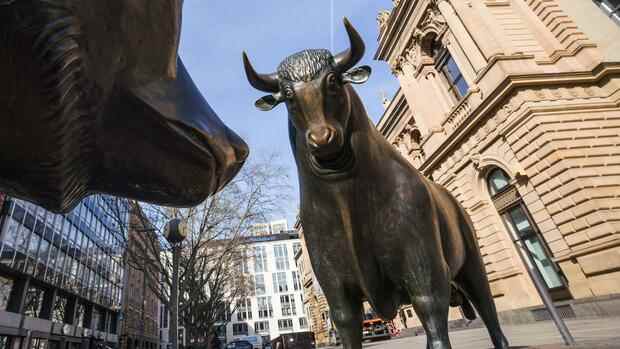It is a market phase characterized by great uncertainty.
(Photo: dpa)
Dusseldorf The German stock market defied the tumble of US tech stocks last week. This trend could continue this week, according to the Handelsblatt survey of more than 7,000 private investors. Because many of them are not yet invested. Their entry into the market would further drive prices.
Sentiment expert Stephan Heibel, who evaluates the weekly survey for the Handelsblatt, attributes this to the persistently high level of uncertainty among the survey participants. After a value of minus 2.0 in the previous week, it is currently minus 1.9. “We can see from this that many investors are not ‘long’ and therefore not benefiting from the rising prices.”
This is also supported by the below-average trading volume. On average, 16 percent fewer Dax titles were traded in October than in September. Significantly fewer investors than before have therefore put positions up for sale. As a result, a comparatively small number of buyers was enough to move prices up.
The German leading index Dax rose by nine percent in October. The month thus confirmed its reputation as a good month for the stock markets after falling by almost six percent in September, which is traditionally weak.
Top jobs of the day
Find the best jobs now and
be notified by email.
Continued gains are beginning to shake investors’ perceptions that the current rally is just another bear market rally — a short streak of rising prices within a long streak of falling prices. “Investors are now struggling with the question of whether it’s already too late to get started and whether they have to watch the trend reversal with impartiality,” says Heibel.
The other survey data are correspondingly complex to interpret. The increase in investor sentiment to a value of plus 0.1 is to be rated positively, after the mood indicators in the current year were always negative with a brief interruption in August. “We can therefore speak of a neutral mood among investors, the really bad mood of the past two months has disappeared for the time being,” says Heibel.
In the meantime, pessimism has become second nature to many investors, says the managing director of the analysis company AnimusX. “The thinking only goes in the direction of when you can sell, no longer when purchases could make sense. This is precisely the breeding ground that could fuel this rally further.” It allows for a steady influx of buyers who have shed their previously pessimistic stance.
In line with the pessimistic mood, future expectations have deteriorated somewhat again, reports Heibel: “After a value of plus 0.1 in the previous week, we measured minus 0.2 this week. So there is again a slight majority for the bears.” Pessimistic investors are referred to as bears. The opposite is the optimistic bulls.
At the same time, however, the willingness to invest has increased from 2.1 to 2.3. Heibel interprets this to mean that investors would buy “if only the prices would come back briefly”.
As in the previous week, Heibel therefore sees the potential for surprises on the stock market as still on the upside. Because on the downside, the courses seem to be well secured, as the Euwax sentiment of the Stuttgart Stock Exchange shows, where private investors trade. It has slipped to minus ten, signaling a sharp increase in hedging.
“Many investors still believe that the price increase is no more than a bear market rally. Accordingly, one is now positioning oneself for the imminent resumption of the bear market. This is a bullish sign as a counter-indicator in terms of sentiment theory,” says Heibel. Because if many investors have positioned themselves for falling prices, they will not be surprised if prices fall again.
Institutional investors are also protecting themselves. The ratio of put options, which professionals use to hedge against falling prices, and call options, which they use to bet on rising prices, has risen to 1.9. So the demand for put options for hedging has increased.
The situation in the USA is different. Here the put/call ratio on the largest futures exchange in Chicago has fallen slightly. In addition, US fund managers have increased their investment ratio from 43 percent to 54 percent. The difference between “bulls” and “bears” has increased to minus 19 percent. So the number of pessimists has fallen from 56 percent to just 46 percent.
The improving sentiment in the US is also reflected in the technical “fear and greed indicator” of the market-wide S&P 500 index. It has risen from extreme fear of greed, the indicator is currently trading at 61 percent.
The “Short Range Oscillator” of the S&P 500, on the other hand, is showing the first signs of overheating, explains Heibel: “The value has jumped to over eight. Values above four are referred to as an overbought market, and a cooldown is likely, at least in the short term.”
Do you want to take part in the survey? Then let yourself be automatically informed about the start of the sentiment survey and register for the Dax sentiment newsletter. The survey starts every Friday morning and ends on Sunday afternoon.
More: Investors make these ten mistakes from the point of view of stock market psychologists

